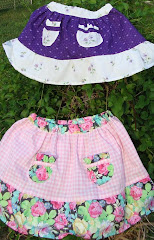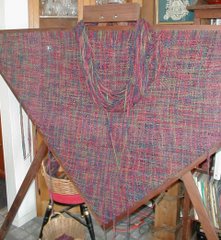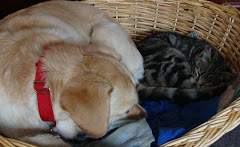
About 10 pounds of beef soup bones became 14 pints of rich beef broth.
One of DH's least favorite jobs couldn't be put off any longer so we tackled the chest and upright freezers last week and discovered several packages of meaty soup bones languishing in the bottom of the chest freezer. We all love vegetable soup but there was too much for a regular batch so I decided to put up most of the stock for later use and added chopped vegetables to the rest to make a pot of soup for immediate consumption.
I've included the basic stock recipe below but it's open to interpretation. For example, throughout the year when I scrape carrots and peel onions, I often throw the unwanted portions (aka carrot peels, onion skins) into a freezer bag for just this kind of cooking. Then when I want to make soup stock, I use those parings as the vegetable basis. If I don't have enough on hand in the freezer, I use unpeeled but scrubbed carrots and the same with onions and celery. No need to trim away the peel as long as it's clean. You almost can't have too many vegetables in the pot -- they all add to the final flavor of the stock after all.
Beef Stock
10 pounds meaty beef bones
3 large, scrubbed carrots, chunked
3 large stalks of celery with leaves, chopped
3 large unpeeled onions, quartered
2 cloves garlic, crushed
1 teaspoon black peppercorns
2 large bay leaves
2 sprigs fresh thyme
Heat oven to 425F. Place all bones in large roasting pan. Bake uncovered for 30 minutes. Add onions, celery, and carrots. Bake, turning tones and vegetables occasionally, an additional 30 minutes or until bones are evenly browned.
Transfer ingredients to a large 2-1/2 gallon stockpot or use large electric roaster oven. If you don't have one pan big enough for the whole amount, split all ingredients evenly between two smaller pots. Add 2 cups water to roasting pan, scraping up browned bits. Pour over bones and vegetables in stockpot. Add at least 1-1/2 gallon additional water or enough water to cover ingredients by 2 inches. Bring just to a boil, skimming foam as needed.
Reduce heat and simmer partially covered for 4 to 6 hours, adding hot water if necessary to keep ingredients submerged. Strain stock through fine sieve of through triple layer of damp cheesecloth-lined colander set over large bowl or pot. Discard solids. (Meat may be pulled from bone and used for another purpose. Taste before using in another recipe as the long cooking pulls much of the flavor from the meat.)
Cool stock overnight in refrigerator. Next day, remove and discard layer of fat. Return stock to pot and bring to a boil. Immediately fill hot quart or pint jars with stock, leaving 1-inch headspace. Wipe jar tops and threads clean. Place hot lids on jars and screw bands on firmly. Using pressure canner, process quarts for 25 minutes and pints for 20 minutes at appropriate pressure for your altitude.
If you've never canned before check out the latest Ball Blue Book of Preserving or the USDA-funded website, National Center for Home Food Preserving, for detailed directions.





















3 comments:
Great blog, thanks!
We are just beginning our adventure into living a more natural life. I homeschool too, and love it!
Have you ever spun Alpaca fiber? I am considering buying a few Alpaca in the spring and have wondered about it. Spinning is one of those things I would love to do when my little guys are a bit bigger.
Also, can you make a stock like this one with turkey bones from Christmas?
I always make turkey stock after I roast a turkey (and chicken stock, but on a smaller scale, whenever I bake a chicken). I make two changes to the beef stock recipe: I don't roast the bones in the oven first and I add a few sprigs of sage along with the thyme. Makes great soup or gravy base or whatever.
Alpaca is lovely to spin! I envy your chance to have a few of your own. A friend gave me a pound of white alpaca sliver and another of a rich natural brown this spring and I can't make up my mind whether to blend it with wool or just spin it as is. For now it's sitting in a couple of large glass jars on a shelf where I can admire it while sewing...
A drop spindle can be a good way to get a little spinning done around all the interruptions normal to family life. I have a couple of wheels but my spindles seem to yield more yarn on a regular basis. Try making a drop spindle from a two cds and a wooden dowel if you want to try spinning w/o a big initial outlay. [Interweave.com has a .pdf file on their site with directions.]
Good luck with your homesteading endeavors! Don't get overwhelmed -- there's always tomorrow and those little guys only stay little for a short time.
Great idea to keep the carrot shavings in the freezer for future stock making!
Post a Comment